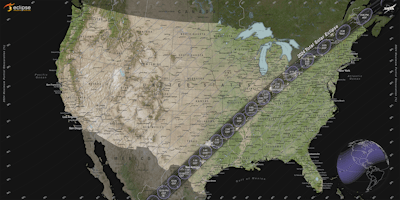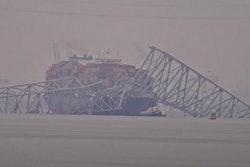 The 2024 total solar eclipse on April 8 will begin around 1:30 p.m. Central time in south Texas and travel northeast through 13 states, exiting the U.S. from Maine around 3:40 p.m. Eastern.NASA
The 2024 total solar eclipse on April 8 will begin around 1:30 p.m. Central time in south Texas and travel northeast through 13 states, exiting the U.S. from Maine around 3:40 p.m. Eastern.NASA
Truckers who have been on the road since at least the summer of 2017 may recall the total solar eclipse that occurred on Aug. 21 of that year, and the additional traffic it brought with it in the areas where the eclipse could be best seen.
That eclipse began in Oregon and traveled southeast over the next couple of hours down to South Carolina.
This year, on Monday, April 8, another total solar eclipse will cross the U.S., this time beginning in Texas and crossing northeast through Maine. It will be observable in the U.S. from around 1:30 p.m. Central time until around 3:40 p.m. Eastern time, with a duration of approximately 4 minutes and 27 seconds, varying based on location.
During that time, it will cross over parts of Texas, including Dallas; Oklahoma; Arkansas; Missouri; Kentucky; Illinois; Indiana; Ohio; Pennsylvania; New York; Vermont; New Hampshire; and Maine. During a total solar eclipse, the moon completely blocks the sun while it passes between the sun and Earth. The sky will darken as if it were dawn or dusk, and those standing in the path of totality may see the sun’s outer atmosphere (the corona) if weather permits.
According to a study of traffic patterns before, during and after the 2017 eclipse, traffic volume decreased two days before the eclipse, except for in Wyoming. Also, traffic increased after the eclipse and returned to normal after two to three days. Three hours before the eclipse, traffic significantly declined by 13%, and two hours post-eclipse, traffic increased by 13% from typical levels.
For this year’s total solar eclipse, AAA has issued a handful of safety recommendations for drivers:
- Keep your vehicle’s headlights on
- Put the sun visor down to block your view of the sun
- Don’t wear eclipse glasses while driving
- Don’t try to photograph or video the eclipse while driving
- Don’t pull over to the side of the road, highway, or interstate to view the eclipse
- Exit the roadway and park in a safe area away from traffic to view the eclipse
- Be mindful of pedestrians who may be walking around with their eyes on the sky
For those interested in seeing the eclipse for themselves, NASA also has a resource of safety tips for viewing.
[Related: When grabbing the right 'bug-out bag' matters]
In preparation for the April 8 eclipse, a number of states in the path of totality are warning drivers of increased traffic as a result of the event.
As reported in December, Arkansas transportation officials called for a “truck holiday” to help ease potential congestion. The Arkansas DOT expects so many eclipse viewers will flock to the state that they will flood the highways, making the day "mostly unproductive for freight vehicles." ArDOT also said it may limit the issuance of oversize permits on the days leading up to and immediately after the eclipse.
Officials in Texas are warning of “heavy traffic and sudden stops by drivers.”
In Kentucky, officials are warning of heavy travel delays, especially after the eclipse, in the western part of the state. The Kentucky Transportation Cabinet will open all lanes in work zones, where possible.
The Indiana Department of Transportation is recommending all movement of oversize/overweight loads be completed the day before or day after the total eclipse (Sunday, April 7 or Tuesday, April 9), as high traffic volumes and heavy congestion are expected the day of the eclipse.
In Illinois, I-57 is the direct interstate access to the path of totality. U.S. 45 runs through the middle of the path of totality. Illinois 1 and Interstates 64 and 70 will provide access to the area. All roads in and out of the area are expected to have heavy congestion in the couple hours after the eclipse.
Vermont officials have issued a Commercial Vehicle Traffic Advisory, “strongly urging commercial motor vehicle drivers traveling to and through Vermont on those dates to consider alternative delivery dates and routes whenever possible to avoid the expected increase in traffic.” Additionally, for April 8, the Vermont DMV will not issue permits for the movement of loads in excess of 108,000 pounds, more than 12 feet wide, or more than 100 feet long.










